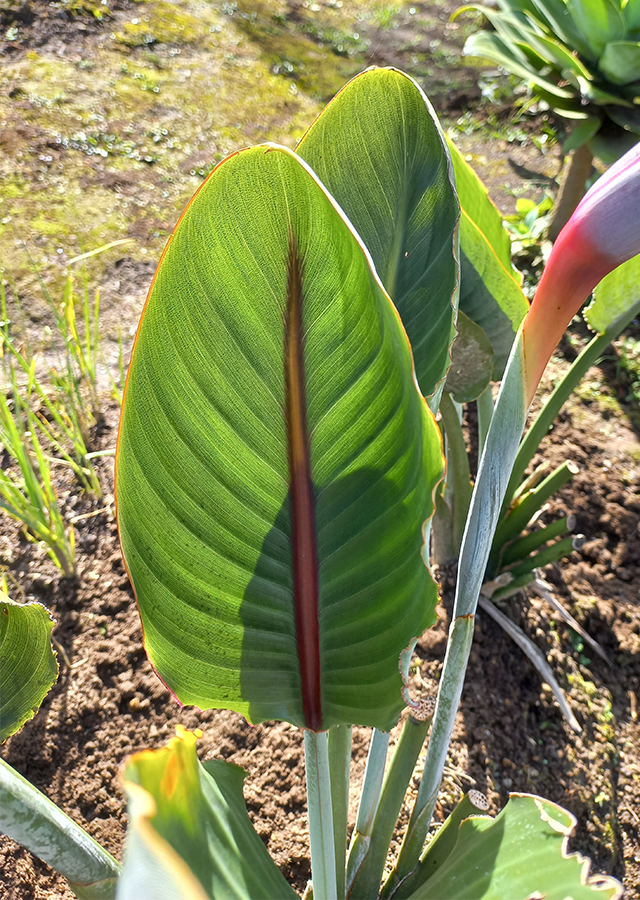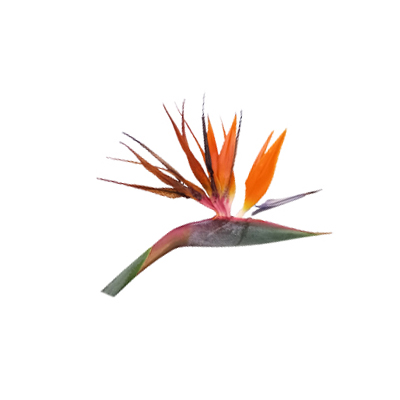Bird of Paradise
Strelitzia reginae Banks
Strelitziaceae
Location in our garden
Principal



Synonym
Strelitzia regalis Salisb.
Habitus
Herbaceous. A clump-forming perennial plant, growing to about 1.2 m tall
Part Used
Flowers
Roots
Growing Requirements
Full Sunshine
Need Shade
Habitat
Riverbanks
Coastal
Overview
Strelitzia reginae is native to South Africa. It was first introduced into Britain in 1773 by Francis Masson. Sir Joseph Banks named the exotic-looking plant Strelitzia in honour of Queen Charlotte, wife of George III and Duchess of Mecklenburg-Strelitz. It is also the official flower of the City of Los Angeles, and in 1952 it was declared the LA flower emblem by Mayor Fletcher Bowron to celebrate the city's 171st anniversary. Apart from being an ornamental plant and cut flower, this species also has benefits as a medicinal plant and has long been used in traditional South African medicine.
Vernacular Names
Oiseau du paradis (French), Paradiesvogelblume (German), Bananeira-rainha (Portuguese), Geelkraanvoel blom (Afrikaans), He wang lan (Chinese).
Agroecology
This plant needs bright light, including some direct sunlight, to bloom well. However, it requires shielding in the direct midday summer sun, which can burn the leaves of younger plants. Bird of paradise prefers high humidity. Use rich, well-drained potting mix for potted plants or a compost mixture. If using a pot, make sure it has ample drainage holes to allow water to flow through the soil and out of the pot. Successful growth indoors is bright light with direct sun, regular watering, and warmth.
Morphology
- Rhizome - underground stem.
- Leaves - greyish-green with long stalks, leaf blades are broad oval shaped, large, up to 70 cm long and 30 cm wide on petioles up to 1 m long.
- Flower - showy with three brilliant orange sepals and three purple or blue petals, bracts green and pink, boat-shaped. Flower consists of three orange outer tepals and three blue inner tepals; two inner tepals are joined together resembling arrowhead shape.
- Fruit - leathery, capsule, has numerous seeds.
- Seed - black with vivid orange arils.
Cultivation
- Generatively propagated by seed.
- Vegetatively propagated by division.
Chemical Constituents
Phenalenones, delphinidin-3-rutinoside, flavonoids (proanthoncyanidin polymers), carotenoids and the anthocyanin-3-rutinoside.
Traditional Medicinal Uses
- In South African traditional medicine used for treatment of urinary tract infections (UTIs) and sexually transmitted diseases (STDs).
- The Zulus use decoction of crushed roots used to relieve symptoms of STDs.
- Strained decoctions from inflorescnece used to treat inflamed glands and venereal diseases.
Part Used
Reference Sources
- Kew Royal Botanic Gardens. (No date). Plants of the World Online: Strelitzia reginae Banks. https://powo.science.kew.org/taxon/urn:lsid:ipni.org:names:798194-1. 15-04-2022.
- National Park of Singapore. (2022). Flora & Fauna Web: Strelitzia reginae. https://www.nparks.gov.sg/florafaunaweb/flora/2/4/2478. 15-04-2022.
- Planter and Forester. (2019). Strelitzia reginae, The Crane Flower, Orange Bird Of paradise. https://www.planterandforester.com/2021/05/strelitzia-reginae-crane-flower-orange.html. 15-04-2022.
- Stuartxchange. (2020). Philippine Medicinal Plants: Bird of paradise. http://stuartxchange.com/BirdOfParadise. 15-04-2022.
- The Spruce. (No date). How to Grow and Care for Strelitzia Plant (Bird of Paradise). https://www.thespruce.com/how-to-grow-strelitzia-1902742. 15-04-2022.


